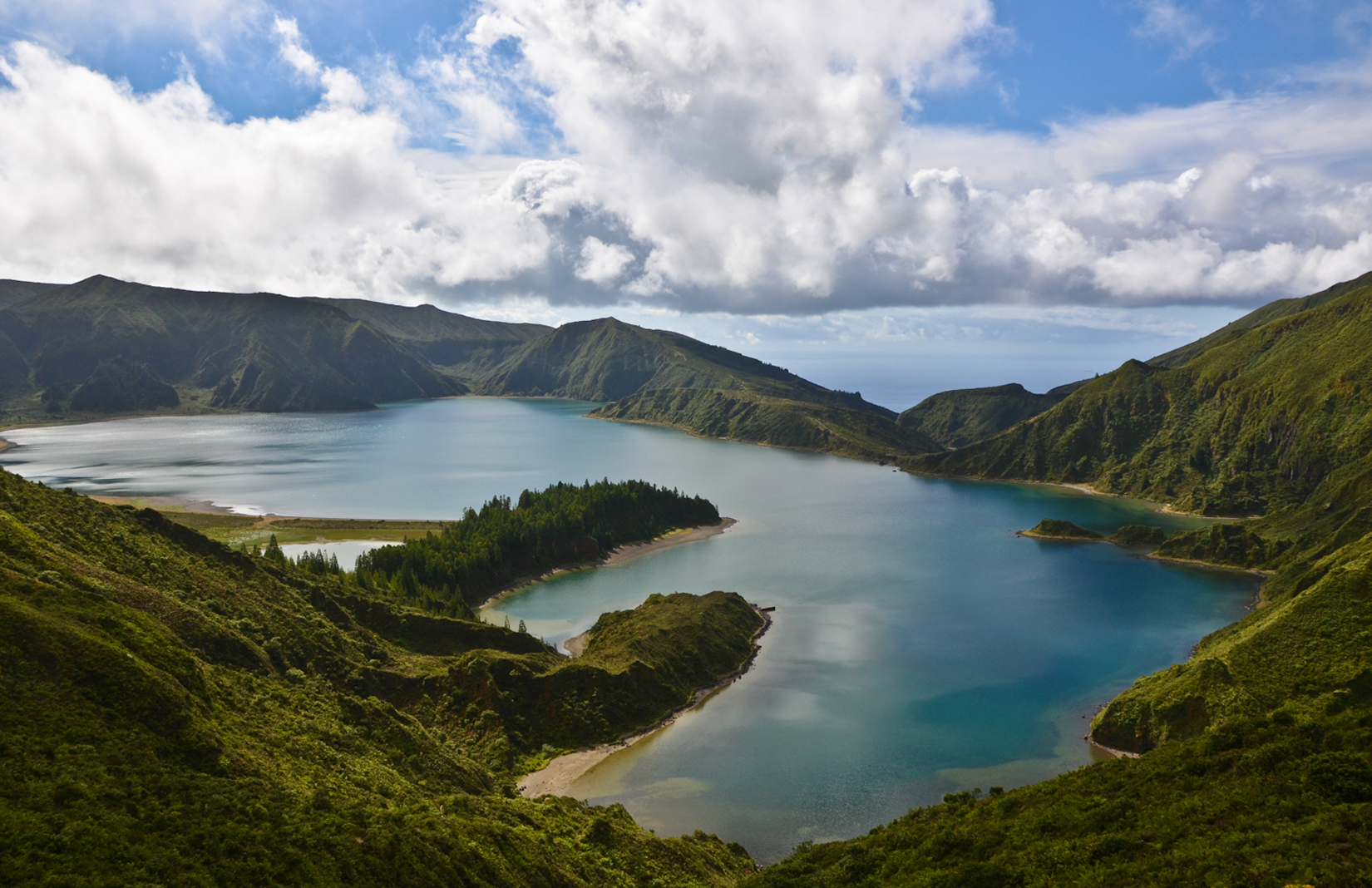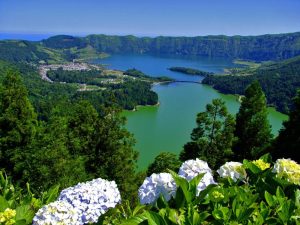- 26 July 2024
- 329
Stunning Islands with Unique Landscapes: Visiting Azores, Portugal

The Azores, an archipelago in the North Atlantic Ocean, is one of Portugal’s best-kept secrets. Comprising nine volcanic islands, this stunning destination offers a unique blend of natural beauty, diverse ecosystems, and rich cultural heritage. In this comprehensive guide, we will explore the breathtaking landscapes, vibrant communities, and myriad activities that make the Azores a must-visit destination for travelers seeking an extraordinary experience.
Geological Formation
The Azores are situated at the meeting point of three major tectonic plates: the North American, Eurasian, and African plates. This unique geological setting has given rise to the islands’ dramatic landscapes, characterized by volcanic craters, thermal springs, and rugged coastlines. The islands themselves are the peaks of underwater mountains, formed through millions of years of volcanic activity.

The Nine Islands
The Azores archipelago is divided into three groups:
Eastern Group**: São Miguel and Santa Maria
Central Group**: Terceira, Graciosa, São Jorge, Pico, and Faial
Western Group**: Flores and Corvo
Each island boasts its own unique features, from lush green pastures and dense forests to barren volcanic landscapes and pristine beaches.
The Green Island
Ponta Delgada, the capital of São Miguel, serves as the gateway to the Azores. This charming city offers a mix of historical architecture, modern amenities, and vibrant cultural events. Key attractions include the 16th-century São Sebastião Church, the City Gates, and the Carlos Machado Museum.
Sete Cidades
Sete Cidades is one of the most iconic landscapes in the Azores. This massive volcanic crater hosts two lakes – Lagoa Azul (Blue Lake) and Lagoa Verde (Green Lake) – which are separated by a narrow isthmus. The contrasting colors of the lakes create a stunning visual effect, best viewed from the Vista do Rei viewpoint.
Lagoa do Fogo
Lagoa do Fogo, or Lake of Fire, is another must-see destination on São Miguel. This pristine crater lake is surrounded by lush vegetation and offers breathtaking views from the surrounding hills. The area is also a protected nature reserve, home to a variety of endemic plant and animal species.
Furnas Valley
The Furnas Valley is renowned for its geothermal activity, with numerous hot springs, fumaroles, and mud pools scattered throughout the area. Visitors can experience the therapeutic benefits of the thermal waters at the Terra Nostra Garden and the Poça da Dona Beija. Additionally, the valley is famous for its “cozido,” a traditional stew cooked underground using natural geothermal heat.
The Festive Island
Angra do Heroísmo, a UNESCO World Heritage site, is the historical capital of the Azores. The city’s well-preserved architecture, cobblestone streets, and vibrant cultural scene make it a captivating destination. Notable landmarks include the Sé Cathedral, the Palácio dos Capitães Generais, and the Monte Brasil volcanic peninsula.
Algar do Carvão
Algar do Carvão is a remarkable volcanic cave located in the interior of Terceira. Visitors can descend into the cave to explore its impressive stalactites, stalagmites, and subterranean lake. The cave’s unique geological features and rich biodiversity make it a fascinating site for both scientists and tourists.
Biscoitos
Biscoitos is a coastal village known for its natural swimming pools, formed by volcanic rock formations. The pools provide a safe and refreshing place to swim, while the surrounding area offers excellent opportunities for hiking and exploring the local vineyards.
Festivities
Terceira is famous for its lively festivals, particularly the “Sanjoaninas” and “Touradas à Corda.” The Sanjoaninas is a week-long celebration in June, featuring parades, concerts, and traditional dances. The Touradas à Corda, or rope bullfights, are a unique cultural event where bulls are led through the streets on a rope, providing a thrilling spectacle for spectators.
Mountain Island
Mount Pico, the highest peak in Portugal, dominates the landscape of Pico Island. Standing at 2,351 meters, the volcano offers a challenging yet rewarding climb for adventurous hikers. The summit provides panoramic views of the surrounding islands and the Atlantic Ocean.
Vineyards and Wine
Pico is renowned for its wine production, particularly its “Verdelho” wine. The island’s vineyards are a UNESCO World Heritage site, characterized by their unique stone-walled plots. Visitors can tour the vineyards, visit the Wine Museum, and sample the island’s distinctive wines.
Whaling Heritage
Pico has a rich whaling history, which is preserved in the island’s museums and cultural sites. The Whalers’ Museum in Lajes do Pico and the Whaling Industry Museum in São Roque do Pico offer insights into the island’s whaling past and its transition to whale watching and conservation.
Caves and Lava Tubes
Pico’s volcanic origins have created a network of caves and lava tubes, such as the Gruta das Torres. This extensive lava tube is one of the longest in Europe, offering guided tours that showcase its impressive geological formations.
Blue Island
Horta, the main town on Faial, is a bustling port known for its marina, which is a popular stop for transatlantic sailors. The marina’s walls are adorned with colorful murals painted by visiting sailors, creating a vibrant and ever-changing gallery. Key attractions in Horta include the Peter Café Sport, the Horta Museum, and the nearby Monte da Guia.
Capelinhos Volcano
The Capelinhos Volcano is a stark reminder of the Azores’ volcanic activity. The volcano erupted in 1957-58, dramatically altering the landscape of Faial. Visitors can explore the volcanic site and visit the Capelinhos Interpretation Centre, which provides an in-depth look at the eruption and its impact on the island.
Caldeira
The Caldeira is a massive volcanic crater located in the center of Faial. The crater is approximately 2 kilometers in diameter and 400 meters deep, offering breathtaking views from the rim. The surrounding area is a protected nature reserve, home to a variety of endemic plant and animal species.
Whale Watching
Faial is an excellent base for whale watching excursions, with numerous tour operators offering trips to see sperm whales, dolphins, and other marine life. The island’s strategic location in the North Atlantic makes it a prime spot for observing these magnificent creatures.
Vila do Corvo
Vila do Corvo, the only settlement on the island, is a charming village with narrow streets, traditional houses, and a picturesque harbor. Key attractions include the Church of Nossa Senhora dos Milagres and the Corvo Municipal Museum.
Caldeirão
The Caldeirão is a massive volcanic crater located in the center of Corvo. The crater features two small lakes and several islets, creating a stunning and serene landscape. Visitors can hike to the rim of the crater for panoramic views of the island and the surrounding ocean.
Birdwatching
Corvo is a prime destination for birdwatching, particularly during the migratory season. The island’s remote location and diverse habitats attract a variety of bird species, making it a haven for ornithologists and bird enthusiasts.
Cultural Heritage
Corvo’s rich cultural heritage is evident in its traditional architecture, crafts, and customs. Visitors can explore the island’s history and culture through local festivals, handicrafts, and culinary traditions.
Sustainable Tourism in the Azores
The Azores are committed to preserving their unique landscapes and ecosystems through sustainable tourism practices. Efforts include the protection of natural reserves, the promotion of eco-friendly activities, and the implementation of conservation programs for endemic species.
Responsible Travel
Visitors to the Azores are encouraged to practice responsible travel by respecting local customs, minimizing their environmental impact, and supporting local businesses. Tips for responsible travel include reducing waste, conserving water and energy, and participating in eco-friendly tours and activities.
Community-Based Tourism
Community-based tourism initiatives in the Azores aim to empower local communities and promote cultural exchange. Visitors can engage with local residents through homestays, cultural workshops, and community-led tours, gaining a deeper understanding of the islands’ heritage and way of life.

Conclusion
The Azores, with their stunning islands and unique landscapes, offer an unparalleled travel experience. From the lush valleys of São Miguel and the volcanic peaks of Pico to the vibrant festivals of Terceira and the serene beauty of Corvo, each island has its own distinct charm and allure. By embracing sustainable tourism practices and responsible travel, visitors can help preserve the natural and cultural treasures of the Azores for future generations to enjoy. Whether you’re seeking adventure, relaxation, or cultural enrichment, the Azores are a destination that promises to captivate and inspire.

